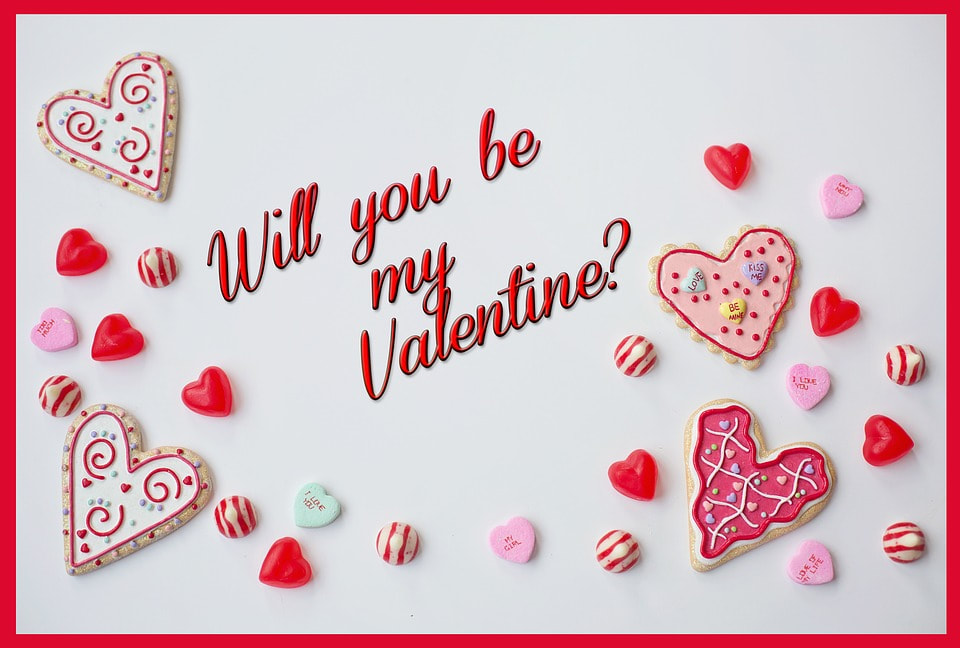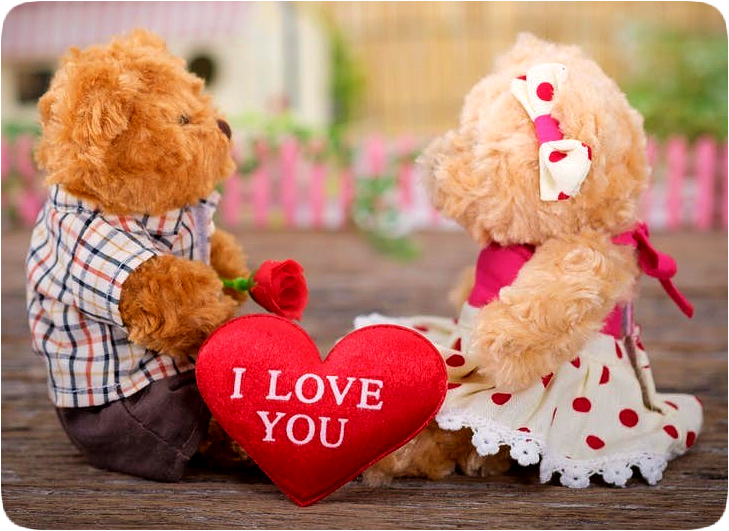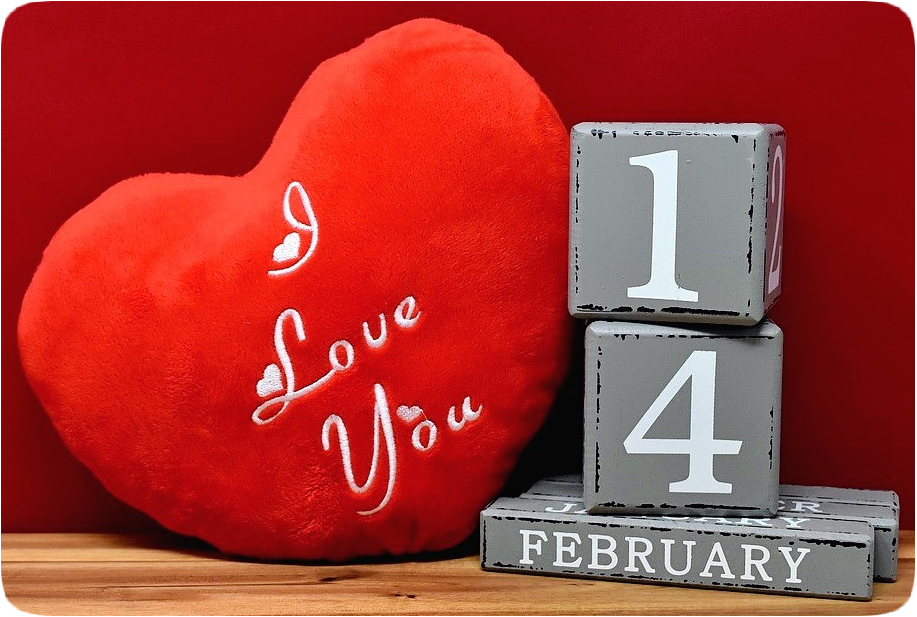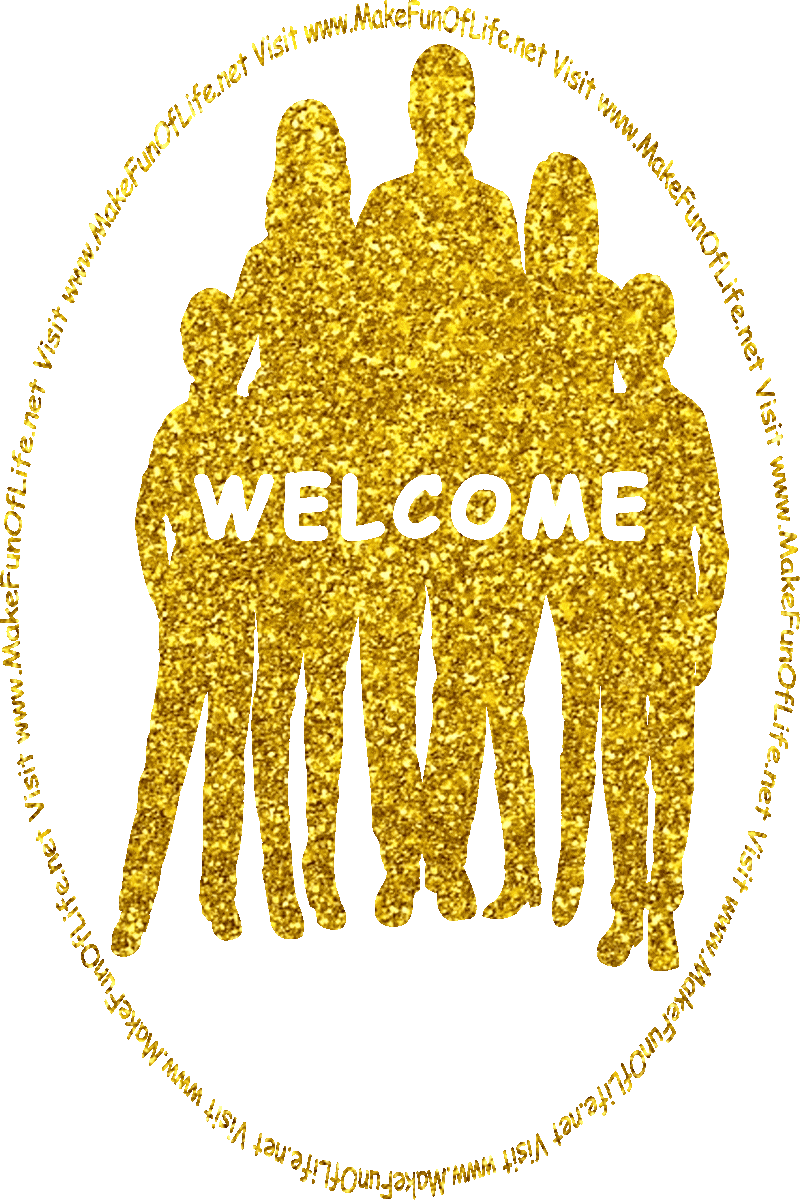Roses are red, my love,
Violets are blue;
Candy is sweet, my love,
But none are as sweet as you!
-Author Unknown
The heart is the most common symbol of romantic love. Ancient cultures believed the human soul lived in the heart. Others thought it to be the source of emotion and intelligence. Some believed the heart embodied a person’s truth, strength, and nobility. The heart may be associated with love because the ancient Greeks believed it was the target of Eros, known as Cupid to the Romans. Anyone shot in the heart by one of Cupid’s arrows would fall hopelessly in love. Because the heart is so closely linked to love, its red color is thought to be the most romantic.
Blue Ribbon, Green Ribbon
If you love me, love me true,
Send me a ribbon, and let it be blue;
If you do not, let it be seen,
Send me a ribbon, a ribbon of green.
by Author Unknown
The color theme of Valentine’s Day is typically red, white, and pink. Red symbolizes warmth and feeling, and is associated with the color of the heart. White is a symbol of purity and faith, and so has come to mean the faith of the love two people have for each other. Pink, a combination of red and white, is a symbol of innocence. Red, white, and pink is common on most cards and decorations, and is found on commercial Valentine’s Day items, such as clothing, stuffed animals, candles, candies, and so forth.
Valentines, valentines
Red, pink, and white
I’ll make a nice one
Just for your delight!
-Author Unknown
The oldest surviving love poem was written on a clay tablet in about 3500 B.C.E., at the time of the Sumerians, who invented writing. It was unromantically labeled ‘Istanbul #2461’ by the archeologists who unearthed it.
Roses are red.
Violets are blue.
Sugar is sweet.
And so are you.
-Author Unknown
Originally, the word ‘Valentine’ meant a person whose name was picked from a box to be chosen as one’s sweetheart. Starting in about 1533, it meant a folded piece of paper with a sweetheart’s name on it. By 1610, it had become the gift given to this special someone, and by 1824 it had become a poem, letter, or verse to a sweetheart. In modern usage, Valentine can refer to a real or a legendary figure by that name, a person for whom one has feelings of love or liking or tolerance, or an object such as a letter or card or other message sent to a person for whom one has feelings of love or liking or tolerance.
About three percent of pet owners give Valentine’s Day gifts to their pets.
One is for lonely
Two is for not.
Be my Valentine
Or I’ll buy a dog named Spot.
-Author Unknown
Valentine’s Day can also be called Saint Valentine’s Day and the Feast of Saint Valentine. The name Valentine is believed to have originated with one or two early Christians by that name, although there are other possible historical figures and legendary, or unverifiable and possibly fictionalized, associated persons by that name. The actual connection of a person named Valentine with a holiday celebrating or observing love and the giving of a message or gift to a loved one is uncertain. Is the origin of the idea in ancient Roman tradition, paganism, or Christianity? We do not know, and the true story of the origins of Valentine’s Day may have been lost in the passage of time.
Knock, knock.
Who’s there?
Darrel.
Darrel, who?
Darrel never be another you!
In long-ago England, the Romans, who had taken over the country, had introduced a pagan festival held every 14 February. After the Romans left England, nearly a century later, the pagan ritual was abolished by Pope Gelsius, who established Saint Valentine’s Day as a celebration of love in C.E. 496.
He: I dreamed I danced with the world’s most beautiful woman.
She: What was I wearing?
The English popularized expressing feelings to someone with printed cards. The first Valentine card was created by Charles, Duke of Orleans, who was imprisoned in the tower of London for several years following the Battle of Agincourt in 1415. He sent Valentine poems to his wife in France from his prison cell. Commercially made Valentines did not appear in England until about 1800, although handmade cards had been popular for years.
I asked you if you liked me, you said no. I asked you if I was pretty, you said no. I asked you if I was in your heart, you said no. I asked you if you would cry if I walked away, you said no. So I walked away . . . you grabbed my arm and said . . . I don’t like you, I love you . . . You’re not pretty, you’re beautiful . . . You’re not in my heart, you are my heart . . . And I wouldn’t cry if you walked away, I would be always lost . . . I love you.
In Wales, wooden love spoons were carved and given as gifts on 14 February. Hearts, keys, and keyholes were favorite decorations on the spoons. The decoration meant, “You unlock my heart!”
Abbie: “Do you love math more than me?”
Danny: “Of course not, dear - I love you much more.”
Abbie: “Then prove it!”
Danny: “Okay, let R be the set of all lovable objects . . .”
The oldest known of what we would recognize as a modern Valentine was sent in C.E. 1415 by the Duke of Orleans to his French wife, while he was imprisoned in the Tower of London. It is now on display in a museum in England.
Knock, knock.
Who’s there?
Adore.
Adore who?
Adore is all that stands between us, my love!
Margery Brews of England wrote the oldest known valentine in letter form, in 1477, which she sent to John Paston. ‘Valentine’ once meant ‘sweetheart’ and later grew to represent ‘message of love.’
Knock, knock.
Who’s there?
Comma.
Comma, who?
Comma little closer and I’ll kiss you!
In the Middle Ages, young men and women drew names from a bowl to see who their valentines would be. They would wear these names on their sleeves for one week. To wear your heart on your sleeve now means that it is easy for other people to know how you are feeling.
Knock, knock.
Who’s there?
Sherwood.
Sherwood, who?
Sherwood like to be your Valentine!
It was not until 1537 that Saint Valentine’s Day was declared an official holiday. England’s King Henry VIII declared 14 February of that year to be a holiday.
Plenty of love,
Tons of kisses -
Hope someday
To be your Mrs.
-Author Unknown
In the 17th century, young British women sprinkled bay leaves with rose water, and then pinned the leaves to their pillows before going to sleep on the eve of Valentine’s Day, in the hope this would make them dream of their future husbands.
Veggie Valentine
You may not ‘carrot’ all for me
The way I care for you.
You may ‘turnip’ your nose
When I plead with you
But if your ‘heart’ should ‘beet’ with mine
Forever ‘lettuce’ hope
There is no reason in the world
Why we two ‘cantaloupe.’
by Author Unknown
When Valentine Cards got to America, they also got more creative. The first known to come to the country is a note written by John Winthrop in 1629 to his wife before leaving England for the New World. It ended with “My sweet wife, Thou must be my valentine for none hath challenged me.” He later became governor of Massachusetts Bay Colony.
Engine, engine number nine,
Will you be my valentine?
-Willard R. Espy (Willard Richardson Espy (1910 - 1999))
People once believed that if a woman saw a robin flying overhead on Valentine’s Day, it meant she would marry a sailor. If she saw a sparrow, she would marry a poor man and be very happy. If she saw a goldfinch, she would marry a wealthy man.
Maribel Clarissa: Whom do birds marry?
Claribel: Their ‘tweethearts’!
On 14 February 1667, Samuel Pepys described in his diary a kind of valentine that he got from his wife. It was a sheet of blue paper in which her name was written in gold letters. This became the forerunner of later valentines. But the custom did not grow quickly. It took 100 years before it was common to leave a valentine love letter at the doorstep of one’s sweetheart.
I wrote a letter to my love,
And on the way I dropped it -
A little puppy picked it up,
And put it in her pocket.
-Author Unknown
In America, hand-made Valentines started appearing around 1740, and were sealed with red wax and left secretly on a beloved’s doorstep, or sent in the mail. Commercial cards for the most part took over in the 1880’s. But people still - and will always - make homemade ones too. Some included trinkets, some locks of hair and in some cases there were checks that were drawn against ‘The Bank of Love.’ Some valentines were printed to look like money, and one so closely resembled a real 5-pound note that it had to be quickly recalled!
Somebody loves you,
Deep and true.
If I weren’t so bashful,
I’d tell you who.
-Author Unknown
Valentines can be done not only in delicate pen and ink, but in watercolor. Handwriting is also a thing of beauty for the card as well, as good penmanship is considered a form of art as well as an indicator of the quality of a person.
Reusable Valentine
If you won’t be my Valentine,
Then give this back to me.
I believe in recycling
To help save a tree.
by Author Unknown
During the American Civil War Era, some Valentines were paper dolls, dressed with cloth or paper to resemble the person sending it.
Popsicles are cold
Cocoa is hot
I’m sending you this incognito
because I like you
a lot.
-Author Unknown
During the Roaring Twenties, or 1920’s, some valentines were shaped like tomatoes. At the time, tomatoes were grown in flower gardens and were an ornamental fruit referred to as ‘love apples.’
Roses are red,
Violets are blue,
Honey is sweet,
And so are you!
-Author Unknown
The red rose was said to be the favorite flower of Venus, the Roman deity of love. Red stands for strong feelings, which is why a red rose is a flower associated with love.
Darling: What do farmers give their wives on Valentine’s Day?
Darlene: Hogs and kisses!
Cupid is a mythical Roman deity. He became associated with Valentine’s Day because he was the son of Venus, the Roman deity of love and beauty. Originally, he was depicted as a handsome young man with a bow and arrows. His arrows were invisible and his victims, who could include other deities as well as humans, were unaware that they had been shot until they fell in love. Victorian era folks sought to make Valentine’s Day more acceptable for women and children, so they tossed out the handsome Roman Adonis image and made cupid into a pudgy baby with wings. Cupid often appears on Valentine cards holding a bow and arrows because he is believed to use magical arrows to inspire feelings of love.
Jerrold: Why did the farmer give the pig a bucket of slop?
Jerry: It was Valenswine’s Day!
●○●○●○●○●○●○●○●○●○●○●○●○●○●○●○●○●○●○●○●○●○●○●○●○●○●○●○●○●
How to Make an Acrostic Valentine
An ‘acrostic’ poem or list can be made from the name of your beloved. Just take the letters of the person’s name and use it to start a line or sentence. Following is an example.
Amanda
A - Another moment without you is
M - more pain than I can bear.
A- And no other love will ever be
N - nearer to my heart than yours.
D - Days pass slowly until we shall meet
A - again and our two lives we forever share.
by Author Unknown
●○●○●○●○●○●○●○●○●○●○●○●○●○●○●○●○●○●○●○●○●○●○●○●○●○●○●○●○●
An Angry Valentine
If you won’t be my Valentine,
I’ll scream, I’ll yell, I’ll bite,
I’ll cry aloud, I’ll start to whine,
If you won’t be my Valentine.
I’ll frown and fret, I’ll mope and pine, and
It will serve you right -
If you won’t be my Valentine,
I’ll scream, I’ll yell, I’ll bite!
by Myra Cohn Livingston (born 1926)
So far, the United States of America, Canada, Mexico, France, Australia, and the United Kingdom officially celebrate the holiday called Valentine’s Day. Will it spread to other nations?
Dear Lisa,
I am in love with you.
I hope you love me too.
I love you more than pizza.
You are so pretty Lisa.
by Author Unknown
Valentine’s Day is second only to Christmas in the number of greeting cards, emails, and other forms of personal messages and wishes between people.
Send lots and lots of Valentine cards, and sign them all anonymously with, “Someone who thinks you’re terrific!”
E-valentines are quick, fun, and easy, but swirly, rosebud graphics and ‘80’s soft jazz tunes may not adequately express your affection. Smilebox lets you incorporate personal photos, videos, and songs in your own personalized card. You send them through email or print them out. One other thing about Smilebox: It’s free! Click on Smilebox.
Bonnie: What do you call a very small valentine?
Lassie: A valentiny!
Teachers receive the most Valentine’s Day cards, followed by children, mothers, wives, and then last but not least, sweethearts. Children ages 6 to 10 exchange more than 650 million Valentine’s cards with teachers, classmates, and family members each year.
So, has your electric utility company sent you a Valentine’s Day card?
Valentine’s Day has changed over time to become what it is today, and is still changing . . . much like MFOL! . . .
Violets are blue;
Candy is sweet, my love,
But none are as sweet as you!
-Author Unknown
The heart is the most common symbol of romantic love. Ancient cultures believed the human soul lived in the heart. Others thought it to be the source of emotion and intelligence. Some believed the heart embodied a person’s truth, strength, and nobility. The heart may be associated with love because the ancient Greeks believed it was the target of Eros, known as Cupid to the Romans. Anyone shot in the heart by one of Cupid’s arrows would fall hopelessly in love. Because the heart is so closely linked to love, its red color is thought to be the most romantic.
Blue Ribbon, Green Ribbon
If you love me, love me true,
Send me a ribbon, and let it be blue;
If you do not, let it be seen,
Send me a ribbon, a ribbon of green.
by Author Unknown
The color theme of Valentine’s Day is typically red, white, and pink. Red symbolizes warmth and feeling, and is associated with the color of the heart. White is a symbol of purity and faith, and so has come to mean the faith of the love two people have for each other. Pink, a combination of red and white, is a symbol of innocence. Red, white, and pink is common on most cards and decorations, and is found on commercial Valentine’s Day items, such as clothing, stuffed animals, candles, candies, and so forth.
Valentines, valentines
Red, pink, and white
I’ll make a nice one
Just for your delight!
-Author Unknown
The oldest surviving love poem was written on a clay tablet in about 3500 B.C.E., at the time of the Sumerians, who invented writing. It was unromantically labeled ‘Istanbul #2461’ by the archeologists who unearthed it.
Roses are red.
Violets are blue.
Sugar is sweet.
And so are you.
-Author Unknown
Originally, the word ‘Valentine’ meant a person whose name was picked from a box to be chosen as one’s sweetheart. Starting in about 1533, it meant a folded piece of paper with a sweetheart’s name on it. By 1610, it had become the gift given to this special someone, and by 1824 it had become a poem, letter, or verse to a sweetheart. In modern usage, Valentine can refer to a real or a legendary figure by that name, a person for whom one has feelings of love or liking or tolerance, or an object such as a letter or card or other message sent to a person for whom one has feelings of love or liking or tolerance.
About three percent of pet owners give Valentine’s Day gifts to their pets.
One is for lonely
Two is for not.
Be my Valentine
Or I’ll buy a dog named Spot.
-Author Unknown
Valentine’s Day can also be called Saint Valentine’s Day and the Feast of Saint Valentine. The name Valentine is believed to have originated with one or two early Christians by that name, although there are other possible historical figures and legendary, or unverifiable and possibly fictionalized, associated persons by that name. The actual connection of a person named Valentine with a holiday celebrating or observing love and the giving of a message or gift to a loved one is uncertain. Is the origin of the idea in ancient Roman tradition, paganism, or Christianity? We do not know, and the true story of the origins of Valentine’s Day may have been lost in the passage of time.
Knock, knock.
Who’s there?
Darrel.
Darrel, who?
Darrel never be another you!
In long-ago England, the Romans, who had taken over the country, had introduced a pagan festival held every 14 February. After the Romans left England, nearly a century later, the pagan ritual was abolished by Pope Gelsius, who established Saint Valentine’s Day as a celebration of love in C.E. 496.
He: I dreamed I danced with the world’s most beautiful woman.
She: What was I wearing?
The English popularized expressing feelings to someone with printed cards. The first Valentine card was created by Charles, Duke of Orleans, who was imprisoned in the tower of London for several years following the Battle of Agincourt in 1415. He sent Valentine poems to his wife in France from his prison cell. Commercially made Valentines did not appear in England until about 1800, although handmade cards had been popular for years.
I asked you if you liked me, you said no. I asked you if I was pretty, you said no. I asked you if I was in your heart, you said no. I asked you if you would cry if I walked away, you said no. So I walked away . . . you grabbed my arm and said . . . I don’t like you, I love you . . . You’re not pretty, you’re beautiful . . . You’re not in my heart, you are my heart . . . And I wouldn’t cry if you walked away, I would be always lost . . . I love you.
In Wales, wooden love spoons were carved and given as gifts on 14 February. Hearts, keys, and keyholes were favorite decorations on the spoons. The decoration meant, “You unlock my heart!”
Abbie: “Do you love math more than me?”
Danny: “Of course not, dear - I love you much more.”
Abbie: “Then prove it!”
Danny: “Okay, let R be the set of all lovable objects . . .”
The oldest known of what we would recognize as a modern Valentine was sent in C.E. 1415 by the Duke of Orleans to his French wife, while he was imprisoned in the Tower of London. It is now on display in a museum in England.
Knock, knock.
Who’s there?
Adore.
Adore who?
Adore is all that stands between us, my love!
Margery Brews of England wrote the oldest known valentine in letter form, in 1477, which she sent to John Paston. ‘Valentine’ once meant ‘sweetheart’ and later grew to represent ‘message of love.’
Knock, knock.
Who’s there?
Comma.
Comma, who?
Comma little closer and I’ll kiss you!
In the Middle Ages, young men and women drew names from a bowl to see who their valentines would be. They would wear these names on their sleeves for one week. To wear your heart on your sleeve now means that it is easy for other people to know how you are feeling.
Knock, knock.
Who’s there?
Sherwood.
Sherwood, who?
Sherwood like to be your Valentine!
It was not until 1537 that Saint Valentine’s Day was declared an official holiday. England’s King Henry VIII declared 14 February of that year to be a holiday.
Plenty of love,
Tons of kisses -
Hope someday
To be your Mrs.
-Author Unknown
In the 17th century, young British women sprinkled bay leaves with rose water, and then pinned the leaves to their pillows before going to sleep on the eve of Valentine’s Day, in the hope this would make them dream of their future husbands.
Veggie Valentine
You may not ‘carrot’ all for me
The way I care for you.
You may ‘turnip’ your nose
When I plead with you
But if your ‘heart’ should ‘beet’ with mine
Forever ‘lettuce’ hope
There is no reason in the world
Why we two ‘cantaloupe.’
by Author Unknown
When Valentine Cards got to America, they also got more creative. The first known to come to the country is a note written by John Winthrop in 1629 to his wife before leaving England for the New World. It ended with “My sweet wife, Thou must be my valentine for none hath challenged me.” He later became governor of Massachusetts Bay Colony.
Engine, engine number nine,
Will you be my valentine?
-Willard R. Espy (Willard Richardson Espy (1910 - 1999))
People once believed that if a woman saw a robin flying overhead on Valentine’s Day, it meant she would marry a sailor. If she saw a sparrow, she would marry a poor man and be very happy. If she saw a goldfinch, she would marry a wealthy man.
Maribel Clarissa: Whom do birds marry?
Claribel: Their ‘tweethearts’!
On 14 February 1667, Samuel Pepys described in his diary a kind of valentine that he got from his wife. It was a sheet of blue paper in which her name was written in gold letters. This became the forerunner of later valentines. But the custom did not grow quickly. It took 100 years before it was common to leave a valentine love letter at the doorstep of one’s sweetheart.
I wrote a letter to my love,
And on the way I dropped it -
A little puppy picked it up,
And put it in her pocket.
-Author Unknown
In America, hand-made Valentines started appearing around 1740, and were sealed with red wax and left secretly on a beloved’s doorstep, or sent in the mail. Commercial cards for the most part took over in the 1880’s. But people still - and will always - make homemade ones too. Some included trinkets, some locks of hair and in some cases there were checks that were drawn against ‘The Bank of Love.’ Some valentines were printed to look like money, and one so closely resembled a real 5-pound note that it had to be quickly recalled!
Somebody loves you,
Deep and true.
If I weren’t so bashful,
I’d tell you who.
-Author Unknown
Valentines can be done not only in delicate pen and ink, but in watercolor. Handwriting is also a thing of beauty for the card as well, as good penmanship is considered a form of art as well as an indicator of the quality of a person.
Reusable Valentine
If you won’t be my Valentine,
Then give this back to me.
I believe in recycling
To help save a tree.
by Author Unknown
During the American Civil War Era, some Valentines were paper dolls, dressed with cloth or paper to resemble the person sending it.
Popsicles are cold
Cocoa is hot
I’m sending you this incognito
because I like you
a lot.
-Author Unknown
During the Roaring Twenties, or 1920’s, some valentines were shaped like tomatoes. At the time, tomatoes were grown in flower gardens and were an ornamental fruit referred to as ‘love apples.’
Roses are red,
Violets are blue,
Honey is sweet,
And so are you!
-Author Unknown
The red rose was said to be the favorite flower of Venus, the Roman deity of love. Red stands for strong feelings, which is why a red rose is a flower associated with love.
Darling: What do farmers give their wives on Valentine’s Day?
Darlene: Hogs and kisses!
Cupid is a mythical Roman deity. He became associated with Valentine’s Day because he was the son of Venus, the Roman deity of love and beauty. Originally, he was depicted as a handsome young man with a bow and arrows. His arrows were invisible and his victims, who could include other deities as well as humans, were unaware that they had been shot until they fell in love. Victorian era folks sought to make Valentine’s Day more acceptable for women and children, so they tossed out the handsome Roman Adonis image and made cupid into a pudgy baby with wings. Cupid often appears on Valentine cards holding a bow and arrows because he is believed to use magical arrows to inspire feelings of love.
Jerrold: Why did the farmer give the pig a bucket of slop?
Jerry: It was Valenswine’s Day!
●○●○●○●○●○●○●○●○●○●○●○●○●○●○●○●○●○●○●○●○●○●○●○●○●○●○●○●○●
How to Make an Acrostic Valentine
An ‘acrostic’ poem or list can be made from the name of your beloved. Just take the letters of the person’s name and use it to start a line or sentence. Following is an example.
Amanda
A - Another moment without you is
M - more pain than I can bear.
A- And no other love will ever be
N - nearer to my heart than yours.
D - Days pass slowly until we shall meet
A - again and our two lives we forever share.
by Author Unknown
●○●○●○●○●○●○●○●○●○●○●○●○●○●○●○●○●○●○●○●○●○●○●○●○●○●○●○●○●
An Angry Valentine
If you won’t be my Valentine,
I’ll scream, I’ll yell, I’ll bite,
I’ll cry aloud, I’ll start to whine,
If you won’t be my Valentine.
I’ll frown and fret, I’ll mope and pine, and
It will serve you right -
If you won’t be my Valentine,
I’ll scream, I’ll yell, I’ll bite!
by Myra Cohn Livingston (born 1926)
So far, the United States of America, Canada, Mexico, France, Australia, and the United Kingdom officially celebrate the holiday called Valentine’s Day. Will it spread to other nations?
Dear Lisa,
I am in love with you.
I hope you love me too.
I love you more than pizza.
You are so pretty Lisa.
by Author Unknown
Valentine’s Day is second only to Christmas in the number of greeting cards, emails, and other forms of personal messages and wishes between people.
Send lots and lots of Valentine cards, and sign them all anonymously with, “Someone who thinks you’re terrific!”
E-valentines are quick, fun, and easy, but swirly, rosebud graphics and ‘80’s soft jazz tunes may not adequately express your affection. Smilebox lets you incorporate personal photos, videos, and songs in your own personalized card. You send them through email or print them out. One other thing about Smilebox: It’s free! Click on Smilebox.
Bonnie: What do you call a very small valentine?
Lassie: A valentiny!
Teachers receive the most Valentine’s Day cards, followed by children, mothers, wives, and then last but not least, sweethearts. Children ages 6 to 10 exchange more than 650 million Valentine’s cards with teachers, classmates, and family members each year.
So, has your electric utility company sent you a Valentine’s Day card?
Valentine’s Day has changed over time to become what it is today, and is still changing . . . much like MFOL! . . .



































































































































